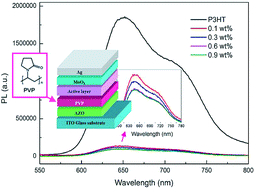Interfacial modification for improving inverted organic solar cells by poly(N-vinylpyrrolidone)
Abstract
The effect of the thickness of the poly(N-vinylpyrrolidone) interface modifier on the photovoltaic performance of inverted organic solar cells was investigated. Superior interface properties provided efficient charge transport and decreased the charge recombination due to PVP interlayer, which reduced the energy barrier for electron extraction by lowering the hydroxide radical amount. We obtained an enhanced efficiency of 4.55% (for the P3HT:PCBM device) and 6.18% (for the PTB7:PC71BM device).


 Please wait while we load your content...
Please wait while we load your content...